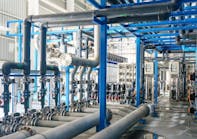Water is a critical part of people’s everyday lives. In parts of the world where access to clean water is impeded, the effects have extensive implications for people and the environment. When a disaster hits, even countries with the safest water supplies can become vulnerable to a myriad of problems.
Proactive planning is necessary to properly prepare for an emergency because during the event responses must often be enacted quickly. As climate change increases the frequency of extreme weather, emergency preparedness grows even more important.
According to David Flinton, senior vice president and president of Xylem Dewatering, two questions arise first when a disaster hits:
- Will we continue to have running water?
- Are we going to have a health crisis to manage?
"The dual challenge of delivering clean water to citizens and removing wastewater safely become top priorities when disasters strike," Flinton notes. Critical infrastructure can be tested during these times, adding to the need for many municipalities to upgrade systems in preparation for potential emergencies.
Mike Morganti, board of directors member for DRI International, also stresses the critical nature of the water supply during an emergency.
"When there is an incident that impairs the public water supply, such as an earthquake, hurricane or other natural disaster, there may be serious health consequences," states Morganti. The loss of pumps could mean the loss of water treatment facilities, while a severe enough drop in pressure could allow groundwater to contaminate the system.
Community safety
As in business, planning is key for communities. With so many potential negative consequences during an emergency, having preplanned steps in place is necessary. Communities must be involved to keep people safe. Flinton believes early warning systems are one way to allow communities to prepare for and minimize the potentially negative impact from any impending emergencies. Communication is also essential.
"When it comes to flood risks, real-time information about precipitation and water quality, water levels and flow rates not only reduces economic losses, it can literally save lives," Flinton explains. One example of such a system alerted Delaware homeowners about the risk of rising flood waters during Superstorm Sandy so they could move to safer regions before roads became impassable. Systems in Virginia and Maryland assured communities they were safe from the storm.
Read also: Understanding water safety during an emergency: Part one
Another example, shares Flinton, is water quality measuring by Taiwan’s Water Resources Agency. The organization uses systems that report turbidity, chlorophyll, pH and dissolved oxygen readings every five meters and every three hours, triggering an emergency plan at the water treatment plant if turbidity reaches critical levels.
In July 2011, pumps were used to divert dangerous wastewater during a fire at New York City’s North River wastewater plant. The Hudson and Harlem rivers received all of the diverted raw sewage because of the fire, but pumps helped divert the sewage to prevent contamination of the rivers and protect human health.
Business emergency strategies
While many businesses use backup generators in case of electricity failure, Morganti states, loss of the power grid also impacts the water supply.
Public water systems often also have backup generators, but they might only last as long as the fuel supply lasts. Morganti adds that this scenario is why it is important to ask:
- What will happen?
- What can happen?
- What will we do when this happens before a disaster hits?
Morganti believes that businesses can have an impact on how employees prepare for disaster situations. Urging workers to have emergency kits for earthquakes, hurricanes or winter weather is one step.
During an emergency, people will vie for the same water supplies, so businesses can keep a company on retainer that can transport water. To prepare for this, companies should look for these businesses from 100 miles away. One downside to this, acknowledged Morganti, is that during a regional disaster, officials could restrict the movement of vehicles or confiscate some resources to distribute them to hospitals or other emergency facilities. Businesses in warmer climates can look for companies that install pools to obtain water that can be used for nondrinking purposes.
How people can prepare
Boil water alerts are often issued when public water supply contamination is possible, but groundwater contamination can also make it unsafe to bathe or brush one’s teeth, adds Morganti.
Mike Morganti recommends filling bathtubs with water to maintain a water supply in preparation of an impending disaster. Photo credit: JazzIRT/iStock
The inability to dispose of solid waste can also be an issue for households. When the water supply is shut off, flushing the toilet is not an option. Morganti advises people to create strategies to make water available for these uses, such as using water from a swimming pool to flush toilets or filling all bathtubs with water.
These strategies are especially important for people who live in disaster-prone areas that often present warnings such as hurricanes. However, Morganti admits, "This is not practical in earthquake-prone areas [since] they occur with little or no warning, so other methods of stockpiling water should be considered, such as capturing rainwater in plastic barrels and storing them for emergency use."
Many municipalities also offer residents assistance with disaster planning. For example, the city of Tucson, Arizona provides a 72-hour kit to help community members prepare their families for emergencies. Its list of required items includes:
- A gallon of water in the car
- A three-day supply of water per person
- Water for pets
The Centers for Disease Control has resources available on what to do during disasters, including how to build emergency water supplies.
Morganti points to the Federal Emergency Management Agency for information on how to boil water, as well as background on purifiers. While carbon filtration is effective against solid or chemical contaminants, it is not good for bacterial contaminants.
Creativity has led to more innovations in water treatment, including one 13-year-old’s discovery of how to filter Giardia out of water using wood.
Even as improvements in technology allow people to better manage disasters, forward thinking ahead of time cannot be understated. "Preparation is the simplest technology to be employed for emergencies," continues Morganti.
Water supplies have a much greater effect on a daily basis than many people realize. Large-scale cooperation is essential to protecting the population from risks during disasters.
"The global water community has a crucial part to play in building global resilience," concludes Flinton. "We must take a collaborative approach in order to successfully tackle the significant challenge that extreme weather events pose. The water industry, governments and NGOs need to work together to pilot and scale technologies in order to develop sustainable, effective and efficient solutions to this complex global challenge."



